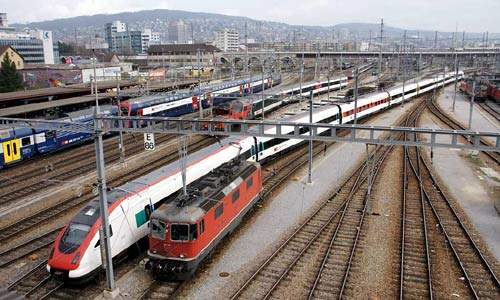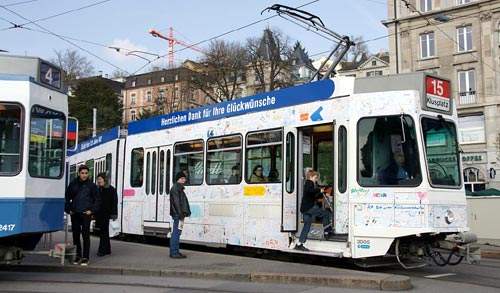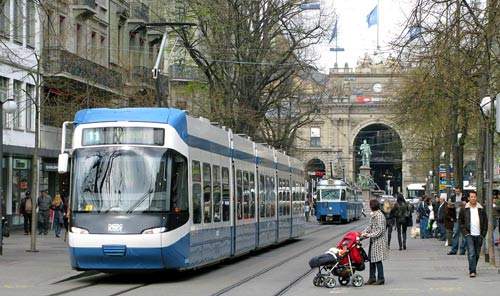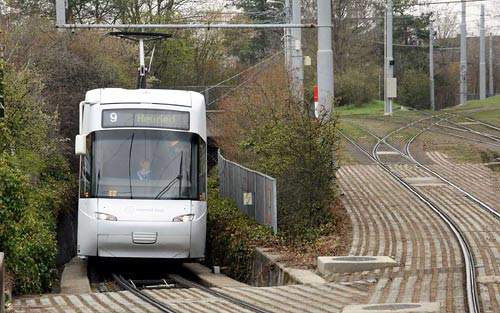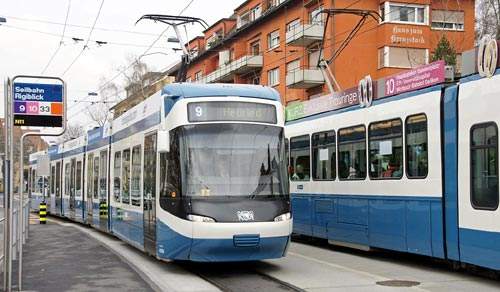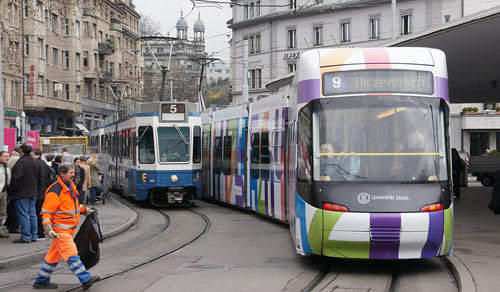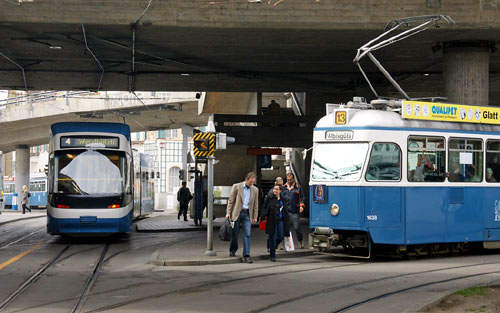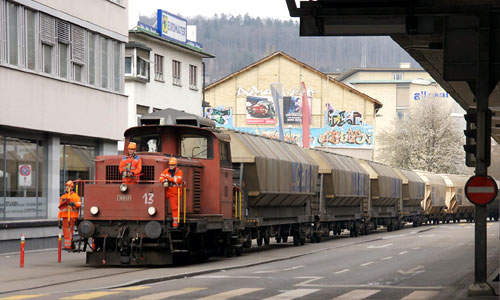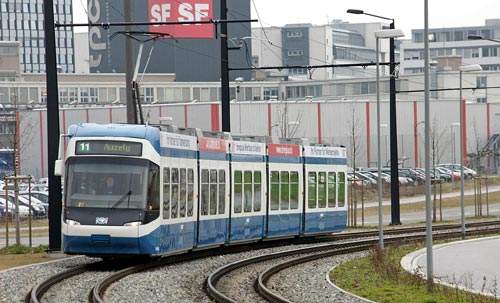Zurich is Switzerland’s largest city and capital of the federal state (canton) of the same name. The canton’s 1,728km² house around a sixth of the national population, and many from neighbouring cantons add to an expanding level of commuting in the area. Added demand is generated by the country’s principal airport in Zurich’s northern community of Kloten.
A large feature of the city centre, the main station, Zurich HB, is a hub for national and international services. Not extreme by Swiss standards, the city’s site at the western end of the Zurchersee (Lake Zurich) nevertheless poses engineering challenges including intensive settlement, substantial hills and the confluence of the Limmat and Sihl rivers.
The project
Zurich’s exceptional public transport arrangements, an aspiration for cities worldwide, remain under development and are the product of an evolving long-term project.
The use of referenda is widespread throughout Switzerland, thus it was that on two occasions, schemes for creating a metro-like tram-in-tunnel ‘tiefbahn’ (as per Dortmund and Köln in Germany) were rejected, although the electorate made it clear that it was specifically the sub-surface aspect that being rejected, not the application of funds for improving public transport and environmental protection.
Some guiding principals are that surface routes, including the tramway with origins in 1882, would continue to be expanded and improved; that public transport modes would get roadway priority; that new building developments had to relate to public transport provision and that pedestrian access to public transport stops would be as easy and agreeable as possible.
Related to making bus, tram or train use even more appealing, tight controls are in place concerning road vehicle access, speeds and parking spaces.
Allied to physical transport provisions are the administrative arrangements, with publicly owned city transport operator Verkehrsbetriebe Zurich (VBZ) being one of many undertakings within Zürcher Verkehrsverbund (ZVV), the cantonal body that integrates all services and provides the multi-mode ticketing system. Even in relatively remote parts, frequency levels are high and scheduled on a ‘clockface’ basis to facilitate easy transfers within and between modes.
Zurich canton’s internal rail services, some extending to neighbouring cantons and into Germany, are mainly provided by national body SBB-CFF-FFS. With services designated ‘S’ according to the S-Bahn system introduced in 1990, there are many interchange points with the tram, with more planned for forthcoming light rail extensions.
Infrastructure
The metre-gauge tramways and new light rail projects are all built with turning loops, leading to the use of the single ended trams with doors on one side only. With a high level of track sharing by tram routes in the central area, much of the system runs along roads and includes reserved alignments.
Consistent with the policy of easy access, the system is almost entirely surface running and features substantial stations at major interchanges like Central, Bahnhof Quai/HB, Bellevue and Bahnhof Enge. The approximately 2km tunnel between Milchbuck and Schwamendingerplatz created for the cancelled metro project was adopted for tram use by the mid-1980s and features three sub-surface stations on routes 7 and 9.
Rolling stock
Zurich is in the midst of replacing part of the earlier tram fleet with the Pininfarina-styled low-floor, five-section Cobra model, a product initially aimed at gaining orders from that city and also from Basel, another large Swiss network (which eventually ordered the Siemens Combino).
Not without difficulties with the design itself and with the original production consortium, an order for 68 Cobras from lead contractor Bombardier in association with Alstom was placed in June 2004.
Subsequent orders up to 2008, including some for the connecting Glattalbahn lines in the north of the city, should see 88 in service around Zurich by 2010.
Perhaps one of the last custom-built tram designs, in original ownership the Cobra seems destined to become peculiar to the Zurich area.
Disposals of the Mirage class dating from 1966 include resale to Ukraine, as did the now-withdrawn Karpfen class. Destined for service at least to 2015 are the several versions of the numerically dominant ‘Tram 2000’ type introduced from 1976, some retro-fitted with low-floor centre cars. Reintroduced in 2003, Zurich’s cargo tram service is deployed as part of the city’s refuse disposal system.
Signalling and communications
VBZ’s integrated services involves trams, buses, trolley buses and funiculars, these covered by a common system under the claim of ‘one ticket for everything’, albeit with many permutations to suit customer needs. Trams are operated according to line of sight principals, with priority over road traffic at junctions.
In practice, the most significant hold ups for trams at intersections in Zurich tend to be the transit of other trams. The traditional roof boards displaying route information are being supplanted by electronic displays on the Cobra fleet and with retro-fitting due on older vehicles. There are prominent service displays at the stops accommodating several routes, and VBZ has a programme of fitting real-time displays throughout.
The future
Two light rail schemes are now in hand that will connect with Zurich’s tram network. The Glattalbahn (being developed by Verkehrbetriebe Glattal AG), part operational by 2006, has a significant opening to Zurich Airport scheduled for 2008.
Postponed through a change of venues for the Euro 2008 football tournament, construction for Tram Zurich-West is due to be formally launched in September 2008. The first major tram network expansion since 1986, the scheme is projected to cost CHF150m, 60% from ZVV, 31% Zurich city, 8% Zurich canton and the remainder by SBB.
Tram Zurich West exists within a wider redevelopment plan, with much of the route being through areas already undergoing substantial change from heavy industry to more modern commercial and residential use. The approximately 3km of new twin-track route with seven new stops will connect the existing complex Escher-Wyss-Platz interchange with a western terminus at Bahnhof Altstetten. This station has connections with the S-Bahn and direct services to Zurich Airport that by-pass Zurich HB.
The project aims to give access to urban transit modes for rail-based commuters without having to continue into the centre. From Escher-Wyss-Platz the tramway will run beneath a road viaduct before turning west at Schiffbau along Pfingstweidstrasse and Aargauerstrasse which will be landscaped with reserved space for trams. By 2025, the population in areas adjoining the new line is forecast to more than double.
The target for the start of public operations is 2011, with the likelihood of a 700m spur to the S-Bahn/bus interchange station Bhf. Hardbrucke being added later which will form a new terminus on a route extension. Prior to this, pedestrian access to Schiffbau will be improved. As Tram Zurich-West infrastructure is added to the network, some existing services will be restructured and redesignated.
Construction could start during autumn 2008 for a December 2011 target completion, with the likelihood of a short spur to the S-Bahn station Bhf. Hardbrücke added later. Some existing services will be restructured and redesignated as new infrastructure is added to the network.
By 2008, VBZ was carrying 40% more passengers than it was 25 years previously. Tram Zurich-West is represented as being the first stage of Liniennetzentwicklung 2025, a transport plan for further expansion deemed appropriate to handling 3% population increase and 11% jobs increase in the area over 20 years. These plans may reduce the role of trolley buses in ZVV operations and will see a growth of lines that facilitate orbital journeys in the metropolitan area.

